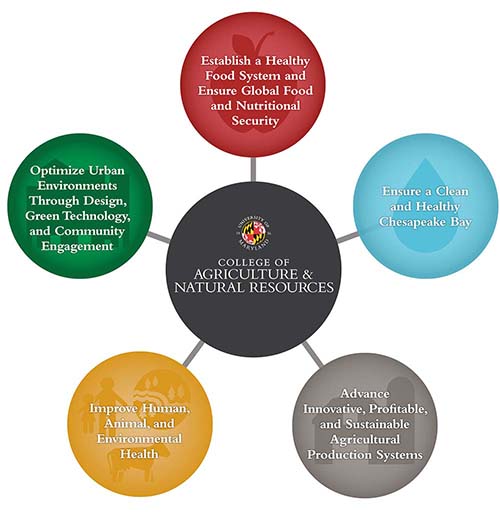AGNR's Strategic Initiatives

As the University's cornerstone college, we embody the land-grant mission with a commitment to eliminate hunger, preserve our natural resources, improve quality of life, and empower the next generation through world-class education.
Establish a Healthy Food System and Ensure Global Food and Nutritional Security
Goals
-
Encourage entrepreneurship in food production, accessibility, availability, and processing.
-
Improve the health and well-being of populations through sharing knowledge of food production, processing, access, and consumption.
-
Inform policy based on sound research.
The following Landscape Architecture classes align with this Strategic Initiative:
- LARC 151 - Urban Agriculture: Designing and Assessing Edible Landscapes
- LARC 160 - Introduction to Landscape Architecture
- LARC 240 - Graphic Communication and Design Studio
- LARC 263 - History of Landscape Architecture
- LARC 265 - Site Analysis and Ecological Principles
- LARC 320 - Principles of Site Engineering
- LARC 321 - Landscape Structures and Materials
- LARC 340 - Site Planning and Design Studio
- LARC 341 - Regional Design Studio
- LARC 420 - Professional Practice
- LARC 452 - Green Infrastructure and Community Greening
- LARC 461 - People and the Environment
- LARC 470 - Landscape Architecture Seminar
- LARC 471 - Capstone Studio: Community Design
Ensure a Clean and Healthy Chesapeake Bay
Goals
-
Design land use management strategies to minimize negative environmental impact.
-
Develop storm water management technologies to improve water quality.
-
Safely apply fertilizer, manure and other nutrients to protect soil health and water quality.
-
Evolve in the face of climate change to address sea level rise and extreme weather.
-
Create environmentally aware communities and promote increased interest and participation.
The following Landscape Architecture classes align with this Strategic Initiative:
- LARC 120 - Digital Fundamentals
- LARC 140 - Graphic Fundamental Studio
- LARC 141 - Design Fundamentals Studio
- LARC 151 - Urban Agriculture: Designing and Assessing Edible Landscapes
- LARC 160 - Introduction to Landscape Architecture
- LARC 221 - Digital Design Tools
- LARC 240 - Graphic Communication and Design Studio
- LARC 263 - History of Landscape Architecture
- LARC 265 - Site Analysis and Ecological Principles
- LARC 320 - Principles of Site Engineering
- LARC 321 - Landscape Structures and Materials
- LARC 340 - Site Planning and Design Studio
- LARC 341 - Regional Design Studio
- LARC 420 - Professional Practice
- LARC 440 - Urban Design Studio
- LARC 452 - Green Infrastructure and Community Greening
- LARC 461 - People and the Environment
- LARC 470 - Landscape Architecture Seminar
- LARC 471 - Capstone Studio: Community Design
Advance Innovative, Profitable, and Sustainable Agricultural Production Systems
Goals
-
Increase plant and animal productivity.
-
Improve and conserve soil health and water quality.
-
Contribute to the success of agricultural businesses.
-
Prepare the next generation for careers in agriculture.
The following Landscape Architecture classes align with this Strategic Initiative:
- LARC 151 - Urban Agriculture: Designing and Assessing Edible Landscapes
- LARC 160 - Introduction to Landscape Architecture
- LARC 263 - History of Landscape Architecture
- LARC 265 - Site Analysis and Ecological Principles
- LARC 320 - Principles of Site Engineering
- LARC 340 - Site Planning and Design Studio
- LARC 341 - Regional Design Studio
- LARC 452 - Green Infrastructure and Community Greening
Improve Human, Animal, and Environmental Health
Goals
-
Create sustainable energy solutions.
-
Decrease chronic diseases and diseases transmitted from animals to humans.
-
Promote and support healthy and livable communities through education.
-
Manage and adapt to climate change.
-
Investigate links between human, animal, and environmental health.
-
Analyze environmental and agricultural policy and inform decision makers.
The following Landscape Architecture classes align with this Strategic Initiative:
- LARC 141 - Design Fundamentals Studio
- LARC 151 - Urban Agriculture: Designing and Assessing Edible Landscapes
- LARC 160 - Introduction to Landscape Architecture
- LARC 240 - Graphic Communication and Design Studio
- LARC 263 - History of Landscape Architecture
- LARC 265 - Site Analysis and Ecological Principles
- LARC 320 - Principles of Site Engineering
- LARC 321 - Landscape Structures and Materials
- LARC 340 - Site Planning and Design Studio
- LARC 341 - Regional Design Studio
- LARC 420 - Professional Practice
- LARC 440 - Urban Design Studio
- LARC 461 - People and the Environment
- LARC 470 - Landscape Architecture Seminar
- LARC 471 - Capstone Studio: Community Design
Optimize Urban Environments Through Design, Green Technology, and Community Engagement
Goals
-
Define and improve the process and perception of urban expansion into rural areas.
-
Improve understanding of agriculture and environmental awareness in urban areas.
-
Improve the performance of built environments.
-
Encourage adoption of green technology by disseminating their benefits
-
Build capacity to develop and adapt sustainable communities
The following Landscape Architecture classes align with this Strategic Initiative:
- LARC 120 - Digital Fundamentals
- LARC 140 - Graphic Fundamentals Studio
- LARC 141 - Design Fundamentals Studio
- LARC 151 - Urban Agriculture: Designing and Assessing Edible Landscapes
- LARC 160 - Introduction to Landscape Architecture
- LARC 221 - Digital Design Tools
- LARC 240 - Graphic Communication and Design Studio
- LARC 263 - History of Landscape Architecture
- LARC 265 - Site Analysis and Ecological Principles
- LARC 320 - Principles of Site Engineering
- LARC 321 - Landscape Structures and Materials
- LARC 340 - Site Planning and Design Studio
- LARC 341 - Regional Design Studio
- LARC 420 - Professional Practice
- LARC 440 - Urban Design Studio
- LARC 452 - Green Infrastructure and Community Greening
- LARC 461 - People and the Environment
- LARC 470 - Landscape Architecture Seminar
- LARC 471 - Capstone Studio: Community Design